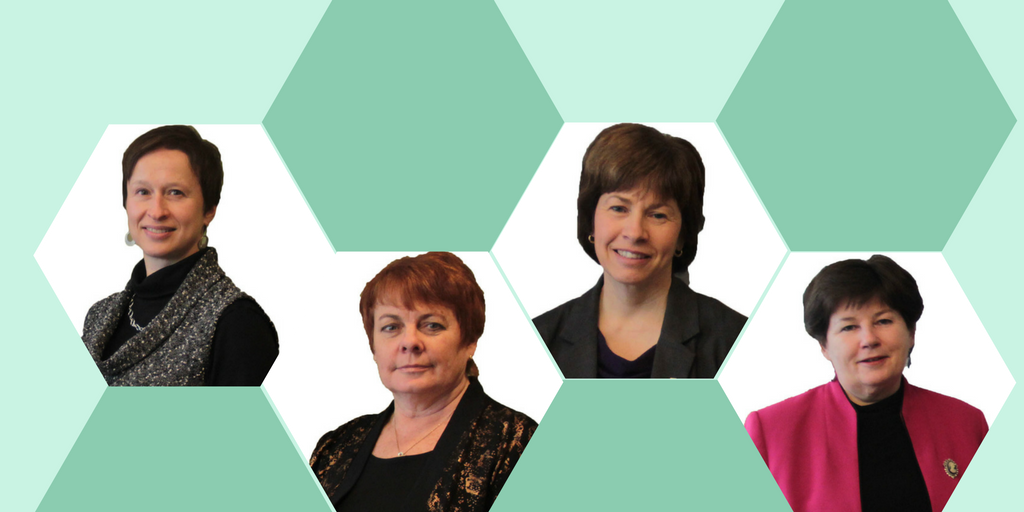The gender makeup of St. Thomas University’s senior administration is unique and unusual.
Less than one fifth of presidents in universities across Canada are female. Dawn Russell, president and vice-chancellor of St. Thomas, is part of this low minority. Even more unusual, however, is the fact that the three vice-presidents she works alongside are all female as well.
“It probably is unique,” said Dawn Russell, “but we don’t think of ourselves that way because we think of ourselves as people who have worked, showed interest in leadership positions and attained them.”
According to them, this makes little difference when it comes to their work.
“In terms of our team, I think in the end, we bring our strengths to the table, and gender doesn’t have anything to do with it,” said Lily Fraser, VP of finance and administration. “I think we bring a certain perspective because of the nature of our background or professional designation.”
This goes for the entire administration as well. The three associate VPs are all male – Jeffrey Carleton, Scott Duguay and Michael Dawson, as well as the dean of social sciences and humanities, Michael Boudreau. According to the female admin, the background of each individual is much more relevant to the work than gender is.
This doesn’t mean gender is a non-existent issue. While becoming increasingly common, finding women in roles of senior leadership is still rare in a university setting. Jodi Misheal, interim VP of advancement and alumni relations, says that it’s indicative of a trend happening across the country for the last 20 years.
“Female students are making up the majority,” said Misheal. “We have 76 per cent of our students at St. Thomas that are female. Even my own undergraduate university 30 years ago, it was 50-50, and now it’s more like 80-20.”
Though gender doesn’t necessarily play a role in the way the current administration operates, it does bring some personal advantages to members of the administration. Kim Fenwick, VP of academic and research, says there’s an inherent respect that comes from working with other women who have been through similar challenges and obstacles.
“We don’t have to work to demonstrate that women deserve the same level of respect that men do,” said Fenwick. “That is something that I think women in leadership positions face in institutions where they’re maybe the sole woman working with a team of men.”
Although Russell says there have been no issues within her team, these can sometimes arise over who people feel comfortable bringing forth ideas to.
“For example, sometimes a board member who hasn’t dealt frequently with women, may feel more comfortable selling an idea to a male member,” said Russell. “Instead of going to the president they might go to a male vice-president, because they feel more comfortable.”
Russell and her VPs agree behaviour like this usually isn’t intentional. The so-called “old boys’ club” filled by men in leadership roles can sometimes subconsciously create a divide.
Russell tries her best to watch out for and police this kind of behaviour.
The old boys’ club can be blamed for a lot of subconscious behaviours or interactions that occur within academic environments. Fenwick was once part of a committee that looked into why women faculty were not applying to positions of academic leadership. At this point, the position of dean was open, and nobody would apply for it.
“Nobody wanted to be a dean,” said Fenwick. “And especially women did not feel that senior administration was a place where women felt comfortable, and that’s certainly changed.”
Fenwick herself was encouraged by many people to apply for the position. But she felt there was no place for her because of her gender. When she expressed this concern, she had men in the senior administration tell her this wasn’t the case, and women were treated equally.
“It’s a blind spot. They think they’re treating people equally with respect and that there’s no longer any kind of barrier based on gender, and yet there is. They just can’t see it because they’re on the side of the majority.”
There’s general agreement among the female administration there is still some work to be done in gender equality, but the progress that has been made is certainly notable and benefits the university in several ways.
Misheal says from an external perspective, charitable organizations and corporations that fund the university’s programs consider gender as an important topic when it comes to working with STU.
“One of the questions that’s always asked is to provide a list of our senior leadership and indicate how many women are in senior leadership positions and how many members of our board are women,” said Misheal. “They’re very much looking for evidence of that gender equality.”
While the gender makeup of the administration may not play a role in the way things are handled internally within the university, just the sight of females in leadership roles can inspire many others.
“I’d say in general the more women who are in female leadership roles, the more role models and the more career examples that people can see,” said VP of finance and administration Fraser.
This is something Fenwick thinks students notice and appreciate about STU, especially when compared to the inequity that can be present in other universities. The presence of women in senior leadership positions is something that Russell hopes can inspire female STU students.
“There’s no doubt that despite the progress that women have made, that there are still ongoing inequities,” said Russell. “In that sense, I hope that looking at our senior leadership team and knowing that everyone was appointed on the basis of merit and the best person available that it will give young women confidence in their future.”

